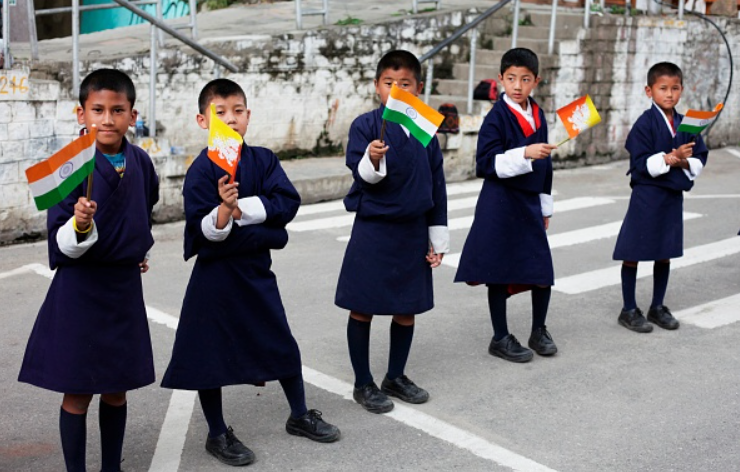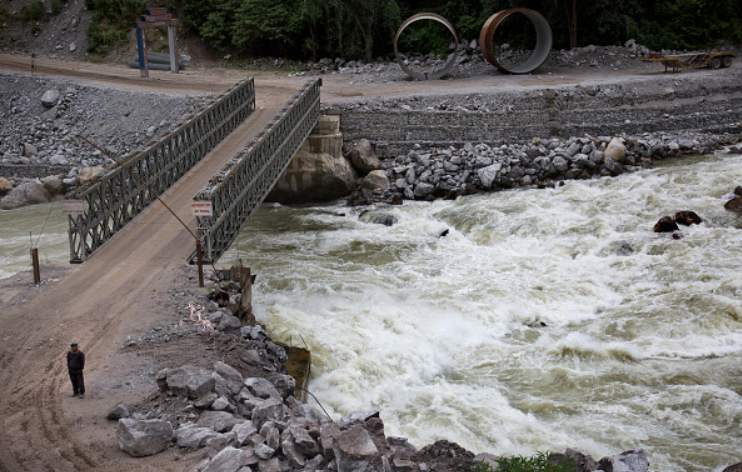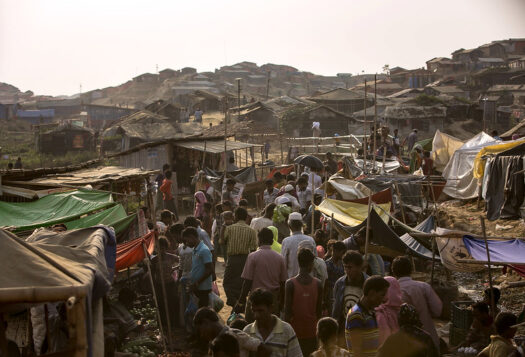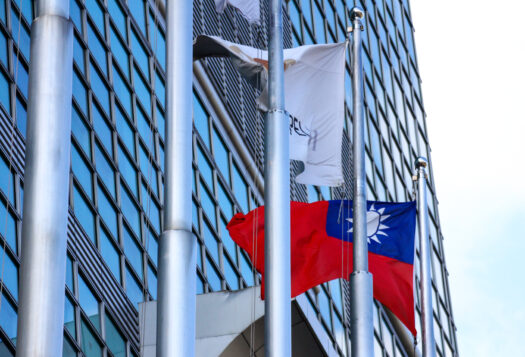
The growing strength of India and Bhutan’s relationship over time has been commended as a model for enduring goodwill between the neighboring states—with state-to-state diplomacy between Thimphu and New Delhi showcased as the success story of friendship.
However, despite the strong bilateral ties, paradiplomacy (also known as subnational diplomacy)—or diplomatic ties between regional governments—has been lacking in India-Bhutan relations. Paradiplomacy reflects a recognition of the diplomatic linkages forged by regional federal government units or even commercial entities. In the case of the Bhutan-India relationship, the most salient paradiplomatic relationships would be between India’s eastern/northeastern states and Bhutan. While India and Bhutan currently have strong bilateral ties, developing the paradiplomatic aspect of the relationship is vital for better addressing wide-ranging concerns from water sharing and security to trade relations and people-to-people ties between the two countries.
Why Paradiplomacy?
Paradiplomacy, as rediscovered in recent international relations literature, is a belated recognition of the regional relationships that were always important and never completely eclipsed by the formal state-level diplomacy that emerged much later. Bhutan has had longstanding trade, political, and pilgrimage connections with the wider Himalayan region, including with Tibetan, Assamese, Sikkimese and many other population groupings that are now part of surrounding countries, including India. These people-to-people interactions, mediated by the regional administrative units, were the basis of long-established economic, political, and cultural ties.
Despite the strong bilateral ties, paradiplomacy (also known as subnational diplomacy)–or diplomatic ties between regional governments–has been lacking in India-Bhutan relations.
Cross-border regions were historically open and vibrant until the European (Westphalian) state system and the emergence of post-colonial countries, combined with great power rivalries between India and China led to reduced cross-border engagements and mobility. More formalized limitations on cross-border movement emerged following India’s independence—standardization of the permit system for cross-border movement between Trashigang and Tawang was raised only in the 1960s, and in the 1970s greater restrictions were placed on winter settlements residents of Dungsam Shumar in Bhutan had in Tsoki, India. Until the 20th century, people in Bhutan and India interacted systematically in a wide variety of ways, and these interactions were governed by leaders of distinct and autonomous political entities from India’s northern frontiers such as Ahom Kingdom, Sikkim, Ladakh and Cooch Behar. As the status of these political entities changed, first during the British colonial period and later after Indian independence, the high-level political interaction of Bhutan with its neighboring polities evolved into formal diplomacy with New Delhi directly.
Independent India historically viewed Bhutan more in terms of strategic competition with China and prioritized this over paradiplomatic aspects of the relationship. Post-colonial India in the initial decades (the 1960s and 1970s) often had to prioritize the interests of Bhutan over those of the Indian states when it came to sourcing the supply of raw materials. Part of the reason for this was the importance for Indian realpolitik vis-à-vis China to bring Bhutan within India’s economic ambit, and away from its northern relations towards Tibet and China. Bhutan was thus historically constructed as “asymmetrically in between” India and China, with its economic and other relations becoming much stronger southwards.
In parallel with formal state diplomacy, interactions across the borders of Bhutan and northeastern India remained significant. Currently, three out of four Thromde (municipality councils) of Bhutan—Phuntsholing, Gelephu, and Samdrup Jongkhar—share a border with India. The economic vibrancy in this region was facilitated by cross-border trade and the daily movement of people. Indian restaurant owners alongside Indian highways near the border with Bhutan speak Tshangla, a language spoken by most of the people of five eastern districts of Bhutan. Some Indian businessmen in Jaigaon, an Indian town bordering Phuntsholing, speak Dzongkha, the national language of Bhutan. Many Bhutanese residing in southern bordering towns speak Hindi. This suggests a high frequency of economic and cultural interactions and the importance the respective peoples attach in understanding one another’s language and culture.
Paradiplomatic Initiatives
In contrast to the initial post-colonial period when formal state diplomacy was the sole focus, there is a growing recognition in India of the importance of paradiplomacy, especially in the economic realm. Indian states are at a nascent stage in paradiplomacy, however, states within the federal structure can engage directly with neighboring countries so long as it does not question the overall direction of the central government’s foreign policy. Various states in Northeast India have shown different degrees of willingness to engage directly with Bhutan, for example, the Chief Minister of Bihar’s proposal to make the state in Bhutan’s hydel power projects in 2011.

Economic regionalism is a prominent foreign policy tool for deepening regional integration. Large economies like India, which have a federal system, can accommodate the specific interests of subnational states/provinces to forge deeper ties with their neighbors. The Bangladesh, China, India, and Myanmar Economic Corridor (BCIM), Bay of Bengal Initiative for Multi-Sectoral Technical and Economic Cooperation (BIMSTEC) and Bangladesh, Bhutan, India and Nepal Motor Vehicle Agreement (BBIN-MVA) are examples of economic policies that promote regional economic cooperation and integration. These groupings also involve some of India’s most politically volatile and least developed regions in the northeast and such initiatives seek to enhance regional stability through trade, infrastructure, and telecommunications connectivity. BBIN was intended to help operationalize paradiplomacy where the northeastern states could play a key role in regional cooperation and India’s Act East Policy. However, BBIN was not ratified in the Bhutanese parliament due to uncertainties about its impact on Bhutan’s “fragile ecosystem and concerns over the absorptive capacity of infrastructure development.”
In contrast to Bhutan’s non-ratification of the BBIN-MVA is the recent implementation of a joint venture for the Kholongchhu hydropower project in eastern Bhutan. While the project has been delayed since its start (the foundation stone was laid in 2014) it is the first-ever Bhutan-India project to be built as a 50:50 joint venture rather than as an agreement between governments. To what extent this opens space for corporate sectors from both the countries to be actors of paradiplomacy in the hydropower arena—regarded as the cornerstone of Bhutan-India relations—remains to be seen.
Paradiplomacy by subnational units is not a feature in Bhutanese foreign policymaking for the country is neither federal nor are the provinces autonomous with their legislatures. However, Bhutan appeared cautiously aware of the challenges and opportunities provided by regional linkages and seeks to develop them wherever feasible within its overall foreign policy. For instance, Bhutan established a consulate in Guwahati, Assam in 2018 to help support trade linkages and people-to-people ties.
Challenges and Opportunities
The main challenge that India-Bhutan relations face at the local level is the ongoing security concerns in Northeast India. Strikes and demonstrations have impacted commerce in border cities, such as Jaigaon—separated from the Bhutan city of Phuntshuoling by a border gate—and whose main customers are Bhutanese. Demonstrations along the border on the Indian side also may mean that the Bhutanese choose not to travel on Indian highways in situations of heightened tensions and unrest, these routes are useful for the Bhutanese due to the absence of lateral highways in southern Bhutan. The continuous presence of the United Liberation Front of Assam and the National Democratic Front of Bodoland is a major security factor in the region. COVID-19 related border closures have underscored the ripple effects that border closures may have on local communities. Despite its smaller economy, many of Bhutan’s migrant workers hail from India. The COVID-19-enforced ban on entry to Bhutan caused significant hardship to daily-waged Indian workers from Assam who secured their livelihood by crossing the international border daily to work in Bhutan. The closures also hurt businesses on the Indian side of the border who depended on Bhutanese customers.
While one may think that this is easy for the Indian state governments to negotiate with Bhutan to secure rights for their workers who depend on the cross-border economy, this is not straightforward. Despite the strong economic ties with India, Bhutan’s domestic and foreign policies are framed with emphasis on its sovereignty and autonomy. The citizens of the two countries have widely different social, political, and economic parameters and expectations of the state system by citizens. Bhutan is a peaceful functioning welfare state with a stricter set of regulations and a high degree of rule compliance. For instance, Bhutan’s COVID-19 pandemic management has been a resounding success story in dramatic contrast with the waves of pandemic devastation in India. As a result, Bhutan’s strategy of combating the pandemic with minimal health impact and fatalities has taken priority over trade, tourism, or business concerns.
Despite the strong economic ties with India, Bhutan’s domestic and foreign policies are framed with emphasis on its sovereignty and autonomy.
Today’s challenges require cooperation and realising the pathways to growing these regional relationships in ways that bring about a shared perception of opportunities is vital. Water security is an area that presents both challenges and opportunities for paradiplomacy between Northeast India and Bhutan. 56 rivers flow down from Bhutan to the eastern state of Assam in India to meet the Brahmaputra River. Different chapters of the Bhutan India Friendship Association’s have been formed in Bhutan’s southern districts/municipalities such as Samdrup Jongkhar and Gelephug and these associations work with local communities to promote resource sharing and management. When international borders were closed in 2020 to contain the COVID-19 pandemic, farmers from Assam’s Baska district could not go to Bhutan to repair the irrigation channels. To ensure a continuous flow of water to Assam, Bhutanese officials coordinated the restoration of irrigation channels. Water systems are one aspect of interdependence among cross-border communities, especially since the problem of flooding can be acute. Thus, while the challenges are significant, the intertwined nature of regional trade, livelihood, resources, and security management means that paradiplomacy can be given much greater attention to bring local concerns to the forefront.
A Cautious Bhutan
From water sharing and security concerns to trade relations and livelihood interlinkages, the interactions between Bhutan and the contemporary Indian northeastern region have been dynamic, frequent, and mostly cooperative. The climate crisis is a reminder that a country-focused approach alone will not work and that cross-border engagement that focuses on local-level impacts is essential.
Bhutan is understandably skeptical of paradiplomatic gestures from Indian states if this means the risk of wading into India’s center-state political tensions.
There are two main reasons Bhutan has been cautious of engaging more with Indian states as opposed to the federal government. First, there is the security aspect concerning Northeast India states. Except for Arunachal Pradesh, several northeastern Indian states are politically volatile and militarized in view of several active anti-India insurgencies. In this situation, even when there is growing interest among Indian states to take a larger role in diplomacy and international cooperation, Bhutan often remains cautious of paradiplomatic initiatives. Second, India’s political priorities have undergone a massive transformation following Modi’s election in 2014 with sharpening political polarization between the ruling BJP party and the opposition parties. This has its counterpart in the center-state political tensions when a non-BJP party rules a state at the federal level. Bhutan is understandably skeptical of paradiplomatic gestures from Indian states if this means the risk of wading into India’s center-state political tensions.
Despite the challenges, scholars need to highlight the possibilities for paradiplomacy and consider the ways to overcome the factors that stand in the way of Bhutan’s direct dealing with India’s northeastern states. Paradiplomatic engagement provides an opportunity to use decentralized and locally relevant ties that reflect historical and current realities to help negotiate people’s interests across borders. There is a long history of people-to-people exchanges across the Bhutan-India border and bringing these connexions to the forefront via subnational diplomacy is a valuable avenue for deepening the friendship between the two countries.
Editor’s Note: This article is part of a joint-series run with 9DashLine exploring the role of subnational diplomacy in South Asia.
***
Image 1: UPASANA DAHAL/AFP via Getty Images
Image 2: Kuni Takahashi via Getty Images


